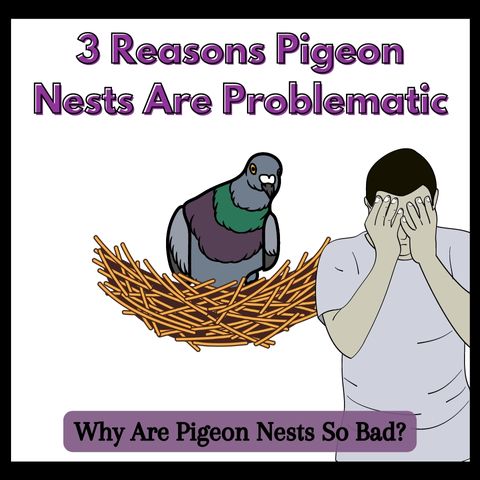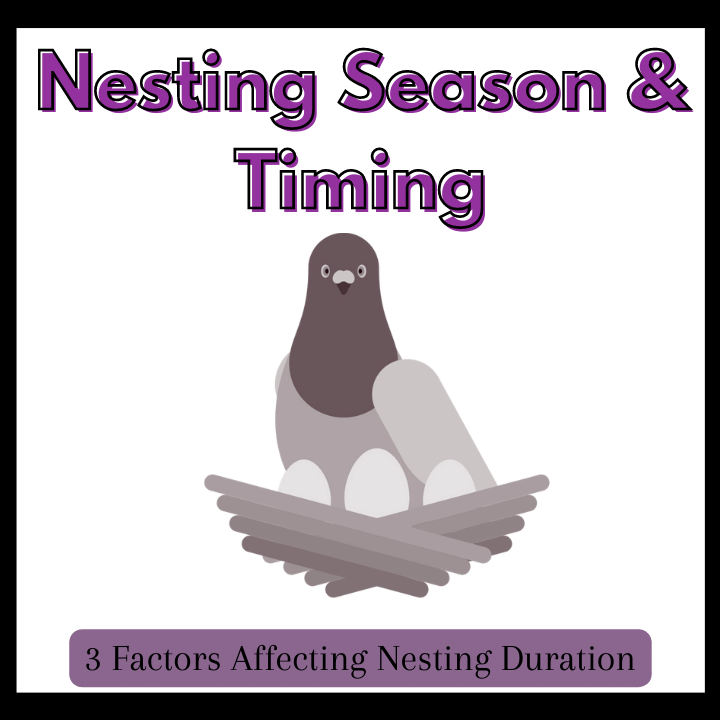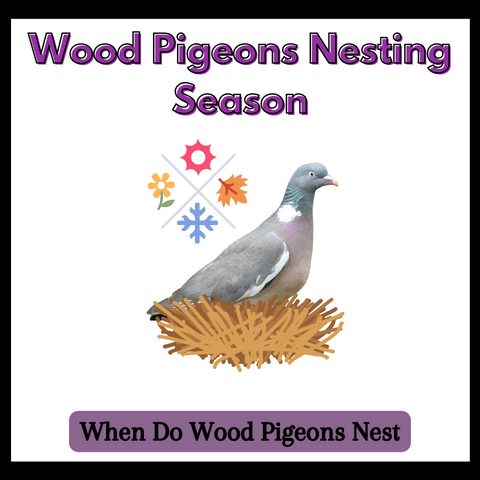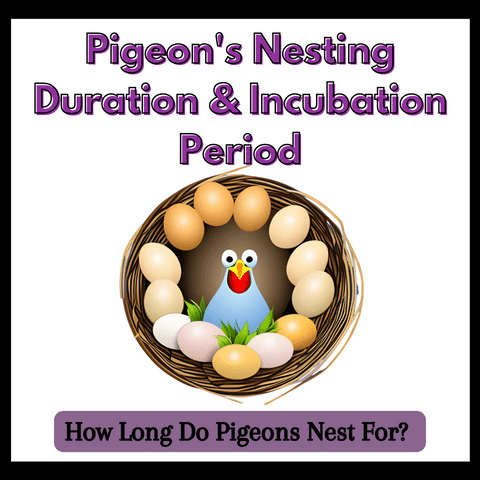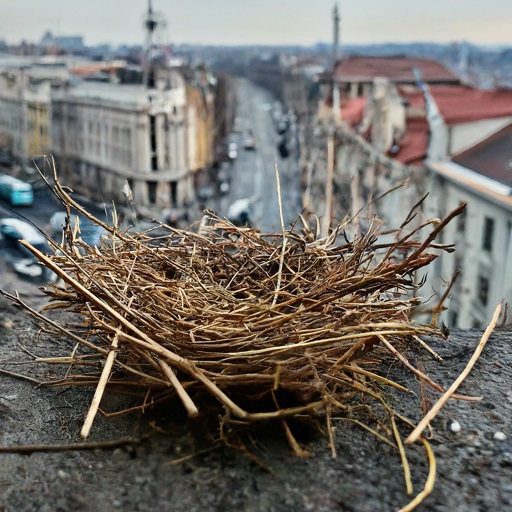Where Do Wood Pigeons Nest? Places to Look For
You are not alone if you are wondering about wood pigeons’ habitat. It is common to ask, ‘Where do wood pigeons nest,’ especially when knowing about their intriguing nesting behavior. These fascinating birds are undoubtedly known for their distinctive cooing sound and beautiful plumage. Hence, in this article, I will help you learn ‘where wood pigeons nest’ in various environments, including forests, urban areas, and rural settings.
Here, you will also delve into the environmental factors that may influence the wood pigeons’ nest site selection. But before I tell you all of these things that help you understand their nesting habits crucial for conservation efforts & urban planning, let’s find out where wood pigeons nest.
Where Do Wood Pigeons Nest?

Wood pigeons are versatile birds that can nest in various locations, ranging from forests, urban areas & rural settings. In particular, they look for dense foliage or evergreen trees that provide good cover. Sometimes, they may nest on buildings like ledges, window sills, or rooftops. Wood pigeons may nest on cliffs or rocky outcrops in more rural or coastal regions.
It’s not uncommon to find wood pigeons nest in trees, shrubs, and hedges of parks & gardens in urban settings. However, its worth noting that wood pigeons are adaptable and can adjust their nesting location depending on the availability of suitable sites & resources. Also, you should know that the specific resting preference of wood pigeons may vary depending on local conditions and the availability of resources in their habitats. Talking about the nesting habits & sites of wood pigeons in different locations or settings, we have shared in-depth knowledge on the question of where wood pigeons nest below.
Nesting Habits of Wood Pigeons
Wood pigeons are known to exhibit versatile nesting behaviors and may able to adapt to different environments based on their specific needs & preferences. Hence below, I am helping you discover their nesting habit in various settings & scenarios.
Nesting Locations in Forest
According to a study conducted by the Department of biological science, wood pigeons prefer deciduous forests due to the availability of varieties of food sources & nesting materials to build their nest. It’s not uncommon for birds like wood pigeons to find suitable nesting sites within the forest environment. However, you should note that wood pigeons are particularly attracted to areas that have abandoned trees & dense foliage.
This kind of forest tends to provide the necessary shelters & resources for the nesting requirements. Wood pigeons build their nest on tree branches, typically using twigs, leaves, and feathers. You can find many national parks & state forests, including wilderness areas and natural reserves, which host diverse tree species, making it an ideal nesting location for wood pigeons. Apart from the wild forest, wood pigeons are also attracted to National parks and nature reserves where they can find lots of mature trees & undisturbed environments. Also, the farm with rich vegetation and abundant food sources attracts many other bird species.
3 Nesting Locations in Urban Areas
Now talking about the nesting locations of wood pigeons in urban areas, you will find some intriguing facts. Wood pigeons have remarkable adaptation ability to urban environments, helping them find nesting opportunities within bustling cities. Many wood pigeons nesting on building rooftops and in urban gardens can be observed. The availability of suitable structures and resources makes the urban area a very attractive nesting site for wood pigeons.
The availability of suitable structures and resources makes the urban area a very attractive nesting site for wood pigeons. The ornithology department states that urban areas are more suitable for wood pigeons as they provide convenient shelter, protection from predators, and proximity to food sources like bird feeders and gardens. Also, this kind of environment often mimics the natural habitats of wood pigeons, helping them to thrive despite human development. Below, I give examples of wood pigeons’ preferred nesting sites in urban settings.
- City Center High-Rise: Rather than going with the short buildings or apartments, wood pigeons often go with the tall ones in city centers as nesting sites because they provide ultimate safety from ground predators and easy access to food sources from nearby green spaces.
- Residential Gardens: You can also witness many wood pigeons nests in well-maintained gardens within urban neighborhoods due to the abundance of trees, shrubs, and bird feeders, making the garden more appealing to all kinds of birds.
- Rooftops of Commercial Buildings: When it comes to large commercial buildings, you often find species like wood pigeons nesting on its rooftop and utilizing the ledges & sheltered space available more effectively.
- College Campus: Like any other pigeon species, wood pigeons also nest in urban college campuses, taking advantage of the green spaces and tall trees available within the campus ground.
- Urban Parks: Lastly, if you are a bird watcher, you might have visited the urban parks where you can observe a lot of beautiful & colorful Birds. There, you will find wood pigeons seeking out dense vegetation and trees to nest amidst the greenery while coexisting with recreational activities.
Nesting Locations in Rural Areas
Talking about rural areas, wood pigeons can also find suitable nesting sites, which encompass open fields, farmlands, and countryside landscapes. These environments are more suitable for wood pigeons as they provide ample food resources and open spaces for nesting compared to other locations. Wood pigeons are known to be attracted to rural areas due to the availability of crops & water sources.
Undoubtedly, the wide expense of farmer land provides an ideal condition for wood pigeons’ nesting habits. If you live in a rural area and have fields where crops like corn, wheat, and sunflowers are grown, you’re most likely to witness wood pigeons & other Birds nesting around. The proximity to these food sources also ensures a steady supply of sustenance for the birds.
Talking about the county states, wood pigeons are often spotted in large states surrounded by Woodlands & meadows due to the peaceful and secure nature of these areas. Other places where wood pigeons may reside, and nest includes rural orchards, lakeside areas, and open meadows. Since rural orchids host an abundance of fruit trees as well as dense foliage for shelter, wood pigeons are particularly attracted to it as a suitable nesting location.
In addition, wood pigeons may also take advantage of the unobstructed space and nearby food sources of open meadows like grass and insects. Lakeside areas where water sources & suitable nesting sides are abundant further make this tranquil environment support the nesting requirement of wood pigeons.
5 Environmental Factors Influencing Nest Site Selection

A few environmental factors may also influence our friends’ wood pigeons’ nest site selection. Since these factors play a crucial role in the survival & successful breeding of wood pigeons, below you will find these factors in detail.
Availability of Food
One of the primary considerations for wood pigeons when choosing nesting sites tends to be food availability & water sources. Therefore, it’s not uncommon for Birds like a wood pigeon to prefer areas with abundant food sources, ensuring a steady supply of sustenance for themselves & their offspring. You should note that wood pigeons tend to have a varied diet requirement, consisting of green seeds and fruits. Therefore, any area with diverse plant species, like Woodlands or grass gardens, tends to be the most attractive place for wood pigeons due to the availability of these food sources. Below I mention the food sources wood pigeons prefer and what amount they need daily.
| Food Sources | Percentage |
| Grains | 40% |
| Seeds | 30% |
| Fruits | 20% |
| Other | 10% |
Shelter & Protection
Another consideration for wood pigeons when selecting a proper nest site tends to be the shelter & protection to save their nest and the young. Therefore, wood pigeons will also seek areas with suitable structures or natural features to protect them from predators and harsh weather conditions. The wildlife conservation society found that wood pigeons preferred nesting in an environment that hosts dense foliage & tall free, providing ample coverage and protection from potential threats. Below I’m mentioning the types of shelter mostly preferred by wood pigeons for nesting purposes.
Sh
Shelter Types | Percentage |
| Dense Foliage | 50% |
| Tall Trees | 30% |
| Building Roofs | 15% |
| Other | 5% |
Nesting Materials
When it comes to building nests, wood pigeons rely on specific materials. To construct their nest, wood pigeons will look out for areas with an abundance of nesting materials, like twigs, leaves, and feathers. According to the Avian Research Institute, wood pigeons predominantly use 60% twigs, 25% leaves, and 15% feathers for nest construction. Therefore if the surrounding environment offers easy access to these materials, you can encourage & attract wood pigeons for nesting purposes.
| Nesting Materials | Percentage |
| Twigs | 60% |
| Leaves | 25% |
| Feathers | 15% |
Accessibility to Water
As I told you earlier, water accessibility is another crucial factor that may influence the preference for nesting sites of wood pigeons. Wood pigeons need nearby water sources for bathing & drinking purposes, especially and particularly during the breeding season. To know more about the wood pigeon nesting seasons, consider reading my recent article on ‘When do wood pigeons nest.’
| Water Sources | Percentage |
| Rivers | 40% |
| Ponds | 30% |
| Bird Baths | 20% |
| Other | 10% |
Nest Predators & Threats
Lastly, another thing that wood pigeons will consider before choosing a nesting site is predators & threats. Since the nesting period tends to be very long for wood pigeons, they need an environment with minimal nest predators & disturbance to ensure the safety of their nest and offspring. Any area that hosts predators like squirrels, Birds Of prey, cats, or human disturbances is a less attractive nesting location for wood pigeons. To help you discover the duration of wood pigeons nesting behavior, consider reading my recent article on ‘How Long Do Wood Pigeons Nest For.’
Conclusion
No doubt, wood pigeons tend to be very adaptable Birds who can nest in various environmental settings, including forest, urban, & rural areas. I have given my best to give you in-depth knowledge on the question ‘Where do wood pigeons nest’ and the factors that may influence their site selection. If you want to make your landscape attractive & suitable for wood pigeon nesting, consider factors like the availability of food shelter, nesting materials, water resources, as well as predators & threats around.
If you consider all the factors properly, you will be able to attract lots of birds, including wood pigeons, in your landscape to enjoy & complement them. If there are any other concerns regarding the question ‘Where do wood pigeons nest,’ consider dropping a comment below. Check my other helpful guide on wood and pigeon nesting behavior. See you in the next posts, till then, take care & goodbye.


